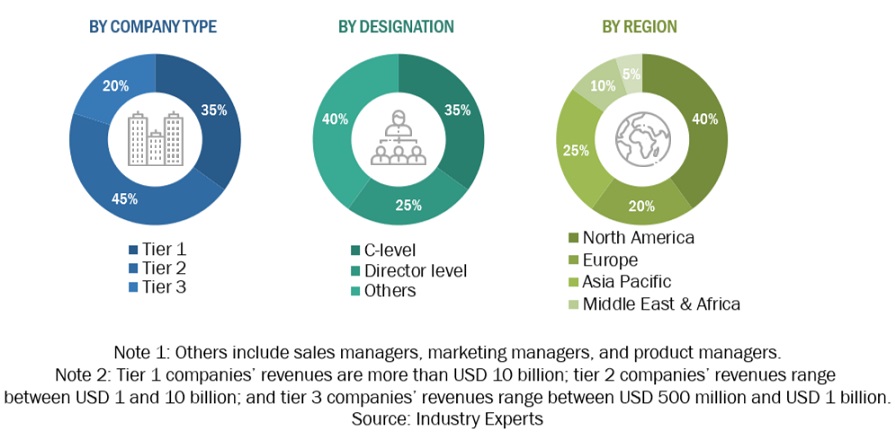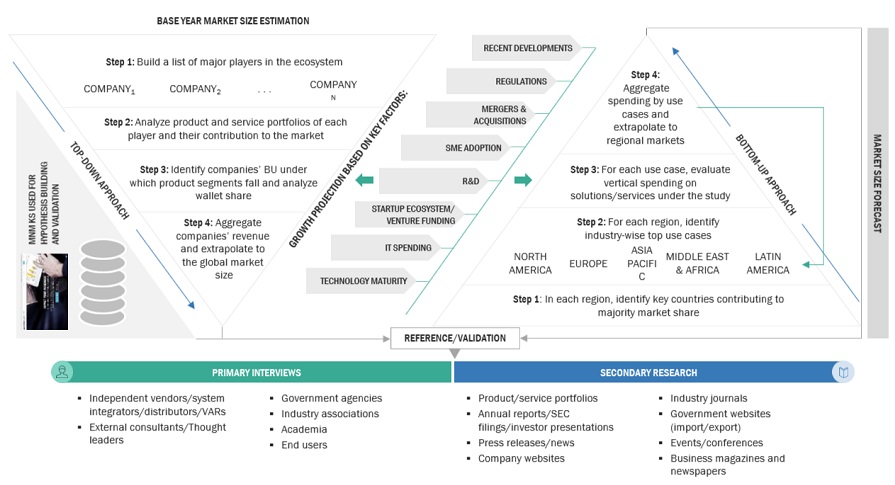The research study for the no-code AI platforms market involved extensive secondary sources, directories, journals, and paid databases. Primary sources were mainly industry experts from the core and related industries, preferred No-Code AI platform providers, third-party service providers, consulting service providers, end users, and other commercial enterprises. In-depth interviews were conducted with various primary respondents, including key industry participants and subject matter experts, to obtain and verify critical qualitative and quantitative information and assess the market’s prospects.
Secondary Research
The market size of companies offering No-Code AI platforms solutions, and services was determined based on secondary data available through paid and unpaid sources. It was also arrived at by analyzing the product portfolios of major companies and rating the companies based on their performance and quality.
In the secondary research process, various sources were referred to identify and collect information for this study. Secondary sources included annual reports, press releases, and investor presentations of companies; white papers, journals, and certified publications; and articles from recognized authors, directories, and databases. The data was also collected from other secondary sources, such as journals, government websites, blogs, and vendors' websites. Additionally, no-code AI platform spending in various countries was extracted from the respective sources. Secondary research was mainly used to obtain key information related to the industry’s value chain and supply chain to identify key players based on solutions, services, market classification, and segmentation according to offerings of major players, industry trends related to offering, technology, data modality, application, and regions, and key developments from both market- and technology-oriented perspectives.
Primary Research
In the primary research process, various primary sources from both the supply and demand sides were interviewed to obtain qualitative and quantitative information on the market. The primary sources from the supply side included various industry experts, including Chief Experience Officers (CXOs); Vice Presidents (VPs); directors from business development, marketing, and No-Code AI platforms expertise; related key executives from No-Code AI platforms solution vendors, System Integrators (SIs), professional service providers, and industry associations; and key opinion leaders.
Primary interviews were conducted to gather insights, such as market statistics, revenue data collected from solutions, and services, market breakups, market size estimations, market forecasts, and data triangulation. Primary research also helps understand various trends related to technologies, applications, deployments, and regions. Stakeholders from the demand side, such as Chief Information Officers (CIOs), Chief Technology Officers (CTOs), Chief Strategy Officers (CSOs), and end users using No-Code AI platforms solutions, and services, were interviewed to understand the buyer’s perspective on suppliers, products, service providers, and their current usage of No-Code AI platforms solutions, and services, which would impact the overall No-Code AI platforms market.
The following is the breakup of primary profiles:

To know about the assumptions considered for the study, download the pdf brochure
No-code AI Platforms Market Size Estimation
Multiple approaches were adopted for estimating and forecasting the no-code AI platforms market. The first approach involves estimating the market size by summation of companies’ revenue generated through the sale of solutions and services.
Market Size Estimation Methodology-Top-down approach
In the top-down approach, an exhaustive list of all the vendors offering solutions, and services in the No-Code AI platforms market was prepared. The revenue contribution of the market vendors was estimated through annual reports, press releases, funding, investor presentations, paid databases, and primary interviews. Each vendor's offerings were evaluated based on the breadth of offerings, technology, data modality, applications, and vertical. The aggregate of all the companies’ revenue was extrapolated to reach the overall market size. Each subsegment was studied and analyzed for its global market size and regional penetration. The markets were triangulated through both primary and secondary research. The primary procedure included extensive interviews for key insights from industry leaders, such as CIOs, CEOs, VPs, directors, and marketing executives. The market numbers were further triangulated with the existing MarketsandMarkets’ repository for validation.
Market Size Estimation Methodology-Bottom-up approach
In the bottom-up approach, the adoption rate of No-Code AI platforms solutions, and services among different end users in key countries with respect to their regions contributing the most to the market share was identified. For cross-validation, the adoption of No-Code AI platforms solutions, and services among industries, along with different use cases with respect to their regions, was identified and extrapolated. Weightage was given to use cases identified in different regions for the market size calculation.
Based on the market numbers, the regional split was determined by primary and secondary sources. The procedure included the analysis of the No-Code AI platforms market’s regional penetration. Based on secondary research, the regional spending on Information and Communications Technology (ICT), socio-economic analysis of each country, strategic vendor analysis of major No-Code AI platforms providers, and organic and inorganic business development activities of regional and global players were estimated. With the data triangulation procedure and data validation through primary values, the exact values of the overall No-Code AI platforms market size and segments’ size were determined and confirmed using the study.
Top-down and Bottom-up approaches

To know about the assumptions considered for the study, Request for Free Sample Report
Data Triangulation
After arriving at the overall market size using the market size estimation processes as explained above, the market was split into several segments and subsegments. To complete the overall market engineering process and arrive at the exact statistics of each market segment and subsegment, data triangulation and market breakup procedures were employed, wherever applicable. The overall market size was then used in the top-down procedure to estimate the size of other individual markets via percentage splits of the market segmentation.
Market Definition
No-code AI platforms aim to democratize artificial intelligence by enabling users to deploy AI and machine learning models through a visual, code-free interface, often with drag-and-drop features. This category includes dedicated no-code AI tools and some automation tools, such as RPA software, that integrate AI capabilities within a no-code interface.
According to C3 AI, no-code is an approach that allows users to create application functionality without writing traditional code. Users design applications and workflows by linking building blocks in a graphical user interface and selecting implementation details via a menu-driven interface. Built on a model-driven architecture, no-code platforms use a declarative approach for writing simplified functions and expressions. These environments target business users or analysts with limited programming experience but substantial domain knowledge to create or modify workflows. They also enable experienced programmers to make quick changes without altering code.
Stakeholders
-
No-Code AI Platforms Solution Providers
-
AI Technology Providers
-
Professional and Managed Service Providers
-
Industry Associations
-
Research Institutions
-
System Integrators
-
Technology Consultants
-
Independent Software Vendors (ISVs)
-
Consulting Firms
-
Value-Added Resellers (VARs)
-
Government Agencies
Report Objectives
-
To define, describe, and predict the No-Code AI platforms market by offering (solutions, and services), technology, data modality, application, and vertical.
-
To provide detailed information related to major factors (drivers, restraints, opportunities, and industry-specific challenges) influencing the market growth.
-
To forecast the market size of segments with respect to five main regions: North America, Europe, Asia Pacific, Middle East & Africa, and Latin America.
-
To strategically analyze micromarkets with respect to individual growth trends, prospects, and contributions to the overall market.
-
To analyze opportunities in the market and provide details of the competitive landscape for stakeholders and market leaders.
-
To analyze competitive developments, such as partnerships, mergers and acquisitions, and product developments, in the market.
-
To analyze the impact of the recession across all the regions in the No-Code AI platforms market.
-
Available Customizations
With the given market data, MarketsandMarkets offers customizations as per the company’s specific needs. The following customization options are available for the report:
Product Analysis
-
The product matrix provides a detailed comparison of the product portfolio of each company.
Geographic Analysis as per Feasibility
-
Further breakup of the North American No-code AI platforms Market
-
Further breakup of the European Market
-
Further breakup of the Asia Pacific Market
-
Further breakup of the Middle East & Africa Market
-
Further breakup of the Latin American No-code AI platforms Market
Company Information
-
Detailed analysis and profiling of additional market players (up to five)



Growth opportunities and latent adjacency in No-Code AI Platforms Market